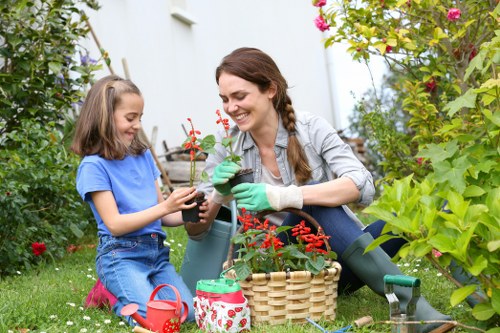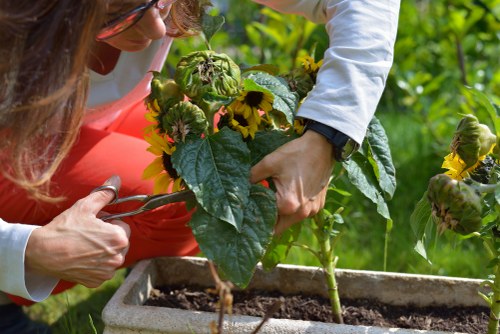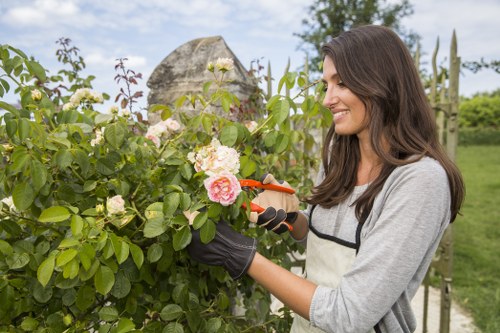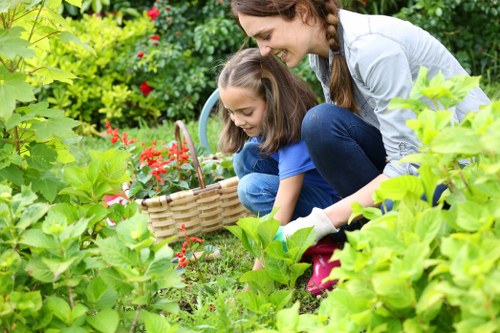Mastering Garden Fence Installation: A Gardener’s Comprehensive Guide
Introduction to Garden Fence Installation

Embarking on a garden fence installation project is a rewarding endeavor for any gardener. A well-installed fence not only enhances the aesthetic appeal of your garden but also provides essential functions such as privacy, security, and delineation of garden spaces.
Whether you’re a seasoned gardener or a hobbyist, understanding the intricacies of garden fence installation can transform your outdoor space into a beautiful and functional haven. This guide delves into the essential aspects of fence installation, providing you with the knowledge needed to execute a successful project.
From selecting the right materials to mastering installation techniques, we cover everything you need to know to ensure your garden fence stands the test of time and complements your gardening efforts.
Benefits of Installing a Garden Fence

Installing a garden fence offers numerous benefits that extend beyond mere aesthetics. Here are some key advantages:
- Privacy: A fence creates a secluded space, allowing you to enjoy your garden without outside distractions.
- Security: It acts as a barrier against unwanted visitors and protects your garden from intruders and livestock.
- Boundary Definition: Clearly defines the borders of your garden, preventing encroachment and maintaining order.
- Wind Protection: Shields your plants from strong winds, reducing damage and promoting healthier growth.
- Enhanced Aesthetics: Adds visual appeal and structure to your garden design.
Understanding these benefits underscores the importance of investing time and resources into a quality garden fence installation project.
With the right approach, a garden fence can significantly elevate the overall gardening experience and the beauty of your outdoor environment.
Choosing the Right Materials for Your Fence

One of the first steps in garden fence installation is selecting the appropriate materials. The choice of materials impacts not only the look and feel of your fence but also its durability and maintenance requirements.
Common Fence Materials
- Wood: Offers a classic and natural appearance. Types like cedar and pine are popular due to their strength and resistance to decay.
- Metal: Includes options like wrought iron, aluminum, and steel. Metal fences are known for their longevity and low maintenance.
- Vinyl: A versatile and low-maintenance option that mimics the appearance of wood without the associated upkeep.
- Composite: Made from a blend of wood fibers and plastic, offering durability and resistance to the elements.
- Chain Link: A cost-effective and durable option, ideal for large gardens requiring extensive coverage.
The selection should align with your garden’s aesthetic, the level of maintenance you’re prepared to undertake, and the climate conditions of your area.
Planning Your Fence Installation

Effective garden fence installation begins with meticulous planning. Proper planning ensures that your fence not only meets your functional needs but also integrates seamlessly with your garden’s design.
Steps for Planning
- Determine the Purpose: Clearly define whether the fence is for privacy, security, decoration, or a combination of these.
- Measure the Area: Accurately measure the perimeter of the area where the fence will be installed to estimate material requirements.
- Check Local Regulations: Consult local building codes and homeowners’ association guidelines to ensure compliance with height restrictions and other regulations.
- Design Considerations: Choose a fence style that complements your garden’s architecture and landscape.
- Budgeting: Establish a budget that includes materials, labor, and any additional costs such as permits or tools.
Thorough planning lays the foundation for a smooth installation process and a fence that serves your needs effectively.
Additionally, considering future garden growth and potential expansions can save you time and resources in the long run.
Installation Techniques and Best Practices

Proper installation techniques are crucial for ensuring the longevity and stability of your garden fence. Adhering to best practices can prevent common issues such as leaning, wobbling, and premature wear.
Step-by-Step Installation Process
- Mark the Fence Line: Use stakes and string to outline the exact path of your fence, ensuring straight lines and correct positioning.
- Dig Post Holes: Typically, holes should be at least one-third the length of the fence post and spaced according to the fence design (usually 6-8 feet apart).
- Set the Posts: Place the fence posts in the holes, ensuring they are level and plumb. Use concrete to secure the posts for added stability.
- Attach Rails and Panels: Once the posts are set, attach the horizontal rails and fence panels according to the chosen design and material specifications.
- Finishing Touches: Seal or paint the fence if necessary, and add gates or decorative elements to complete the installation.
Following these steps diligently will result in a sturdy and visually appealing fence that enhances your garden’s overall appeal.
Regular maintenance, such as inspecting for damage and applying protective coatings, can extend the lifespan of your fence.
Maintenance Tips for Longevity
Once your garden fence is installed, proper maintenance is essential to ensure its longevity and continued functionality. Here are some maintenance tips tailored for different fence materials:
Wood Fences
- Regularly inspect for signs of rot or insect damage.
- Apply sealant or paint every few years to protect against moisture and UV damage.
- Replace any damaged boards promptly to maintain structural integrity.
Metal Fences
- Clean the fence periodically to remove dirt and debris.
- Inspect for rust and apply protective coatings as needed.
- Ensure that all components are securely fastened to prevent loosening.
Vinyl and Composite Fences
- Wash the fence with mild soap and water to remove stains.
- Inspect for any cracks or damage and repair promptly.
- Avoid using harsh chemicals that can degrade the materials.
Consistent maintenance not only preserves the appearance of your fence but also extends its lifespan, ensuring that it continues to serve its intended purpose effectively.
Enhancing Your Garden with Decorative Fencing
Beyond functionality, garden fences can be a canvas for creative expression, enhancing the beauty and character of your outdoor space. Here are some ideas to add a decorative touch to your fence installation:
Incorporate Climbing Plants
- Vines: Planting climbing vines like ivy or jasmine can add greenery and fragrance to your fence.
- Flowering Climbers: Roses, clematis, and wisteria not only beautify the fence but also attract pollinators to your garden.
- Trellises: Adding trellises or lattice panels can provide support for climbing plants and enhance the decorative appeal.
Artistic Elements
- Decorative Panels: Incorporate metal or wooden decorative panels with intricate designs.
- Painted Patterns: Use vibrant colors or patterns to make your fence a focal point of the garden.
- Lighting: Installing fairy lights or solar-powered lights can create a magical ambiance in the evenings.
These enhancements not only elevate the aesthetic appeal of your garden but also reflect your personal style and creativity.
Choosing the Right Gardener for Fence Installation
Selecting a professional gardener for your fence installation ensures that the project is executed with expertise and attention to detail. Here are some factors to consider when choosing the right gardener:
Experience and Expertise
- Look for gardeners with a proven track record in fence installation.
- Check for specialized knowledge in the type of fencing material you’ve chosen.
- Review portfolios or past projects to assess quality and style.
Reputation and Reviews
- Seek recommendations from friends, family, or online reviews.
- Verify credentials and licenses if applicable.
- Ensure the gardener has positive feedback for reliability and workmanship.
Cost and Value
- Obtain multiple quotes to compare pricing structures.
- Assess the value offered in terms of materials, labor, and additional services.
- Be cautious of prices that seem unusually low, as they may indicate compromised quality.
Choosing the right gardener can make a significant difference in the outcome of your garden fence installation, ensuring that it meets your expectations in both functionality and aesthetics.
Don’t hesitate to ask for references or conduct interviews to find a gardener who aligns with your project goals and budget.
Common Challenges and Solutions
Garden fence installation can come with its own set of challenges. Being prepared with solutions can help you navigate these issues effectively.
Uneven Terrain
- Issue: Sloping or uneven ground can make fence installation more complex.
- Solution: Level the ground before installation or use adjustable fence posts to accommodate terrain variations.
Permitting and Regulations
- Issue: Navigating local building codes and obtaining necessary permits can be time-consuming.
- Solution: Research local regulations beforehand and consult with a professional gardener who is familiar with the requirements.
Poor-Quality Materials
- Issue: Using subpar materials can lead to a short lifespan and frequent repairs.
- Solution: Invest in high-quality materials that are suitable for your climate and garden conditions.
Addressing these challenges proactively ensures a smoother installation process and a durable, attractive fence that enhances your garden for years to come.
Consulting with experienced gardeners and conducting thorough research can help mitigate potential issues during fence installation.
Cost Considerations for Fence Installation
Understanding the cost factors associated with garden fence installation is crucial for budgeting and planning.
Factors Influencing Cost
- Material: Different materials vary in cost. For example, wood is generally less expensive than metal or composite materials.
- Labor: Professional installation costs can vary based on the complexity of the project and regional labor rates.
- Fence Height and Length: Larger and taller fences require more materials and labor, increasing the overall cost.
- Design Features: Decorative elements, gates, and custom designs add to the total expense.
- Site Preparation: Clearing the area and addressing uneven terrain may involve additional costs.
Budgeting Tips
- Get Multiple Quotes: Obtain estimates from several gardeners to compare prices and services.
- Prioritize Needs: Determine which features are essential and which can be modified to fit your budget.
- Plan for Extras: Allocate a portion of your budget for unexpected expenses or upgrades.
- Consider DIY Options: For those with the skills, undertaking parts of the installation can reduce labor costs.
By carefully considering these factors and planning accordingly, you can achieve a high-quality garden fence installation that aligns with your financial plans.
Investing wisely ensures that your fence not only meets your functional needs but also enhances the overall value and appearance of your garden.
Sustainable Practices in Fence Installation
Incorporating sustainable practices into your garden fence installation reflects a commitment to environmental responsibility and long-term garden health.
Eco-Friendly Materials
- Recycled Materials: Opt for fences made from recycled metals or composite materials to reduce environmental impact.
- Sustainably Sourced Wood: Choose wood from certified sustainable sources to ensure responsible forestry practices.
- Bamboo Fences: Bamboo is a rapidly renewable resource that provides a durable and eco-friendly fencing option.
Resource-Efficient Installation
- Minimize Waste: Plan accurately to reduce material waste and recycle any leftover materials.
- Energy-Efficient Practices: Use manual tools or energy-efficient equipment during installation.
- Natural Barriers: Incorporate living fences or hedges as part of your fence installation to enhance biodiversity.
Adopting these sustainable practices not only benefits the environment but also contributes to a healthier and more resilient garden ecosystem.
Conclusion: Elevate Your Garden with Professional Fence Installation
Investing in professional garden fence installation brings numerous advantages, from enhanced privacy and security to aesthetic improvements and boundary definition. By carefully selecting the right materials, planning meticulously, and adhering to best installation practices, you can achieve a durable and beautiful fence that complements your gardening efforts.
Don’t wait to transform your garden into the sanctuary you’ve always envisioned. Contact us today to discuss your garden fence installation needs and take the first step toward a more organized, secure, and visually appealing outdoor space.